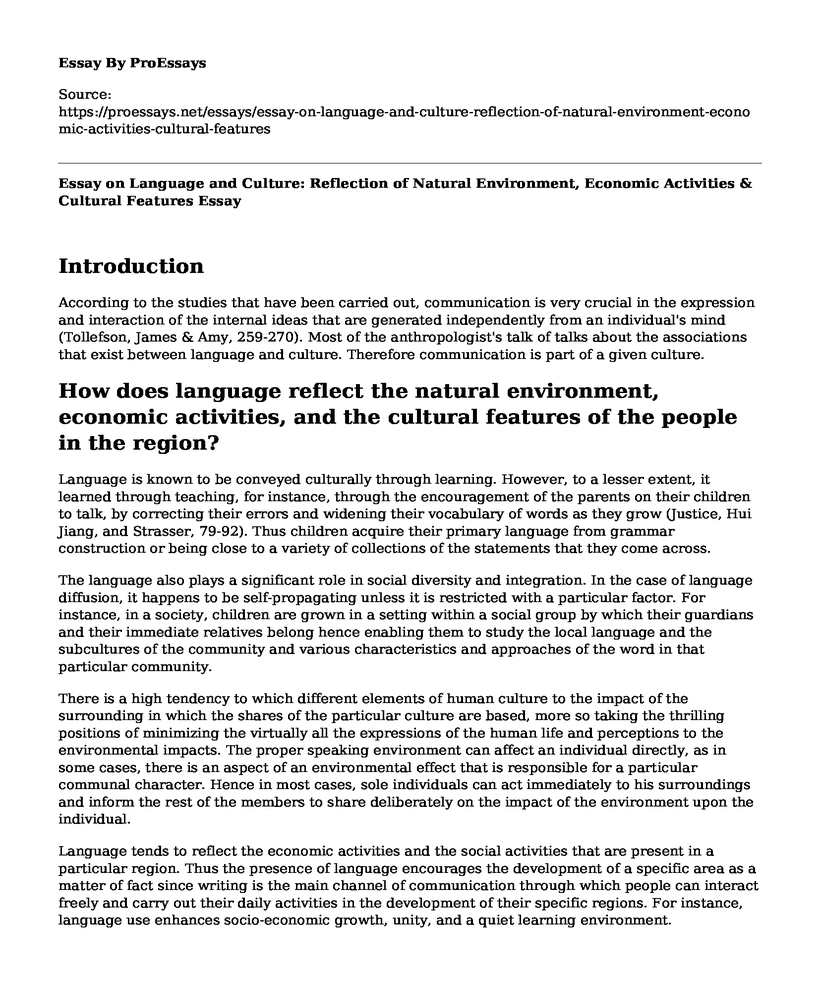Introduction
According to the studies that have been carried out, communication is very crucial in the expression and interaction of the internal ideas that are generated independently from an individual's mind (Tollefson, James & Amy, 259-270). Most of the anthropologist's talk of talks about the associations that exist between language and culture. Therefore communication is part of a given culture.
How does language reflect the natural environment, economic activities, and the cultural features of the people in the region?
Language is known to be conveyed culturally through learning. However, to a lesser extent, it learned through teaching, for instance, through the encouragement of the parents on their children to talk, by correcting their errors and widening their vocabulary of words as they grow (Justice, Hui Jiang, and Strasser, 79-92). Thus children acquire their primary language from grammar construction or being close to a variety of collections of the statements that they come across.
The language also plays a significant role in social diversity and integration. In the case of language diffusion, it happens to be self-propagating unless it is restricted with a particular factor. For instance, in a society, children are grown in a setting within a social group by which their guardians and their immediate relatives belong hence enabling them to study the local language and the subcultures of the community and various characteristics and approaches of the word in that particular community.
There is a high tendency to which different elements of human culture to the impact of the surrounding in which the shares of the particular culture are based, more so taking the thrilling positions of minimizing the virtually all the expressions of the human life and perceptions to the environmental impacts. The proper speaking environment can affect an individual directly, as in some cases, there is an aspect of an environmental effect that is responsible for a particular communal character. Hence in most cases, sole individuals can act immediately to his surroundings and inform the rest of the members to share deliberately on the impact of the environment upon the individual.
Language tends to reflect the economic activities and the social activities that are present in a particular region. Thus the presence of language encourages the development of a specific area as a matter of fact since writing is the main channel of communication through which people can interact freely and carry out their daily activities in the development of their specific regions. For instance, language use enhances socio-economic growth, unity, and a quiet learning environment.
Works Cited
Justice, Laura M., Hui Jiang, and Katherine Strasser. "Linguistic environment of preschool classrooms: What dimensions support children's language growth?." Early Childhood Research Quarterly 42 (2018): 79-92.
Tollefson, James W., and Amy BM Tsui. "Issues in language policy, culture, and identity." Language policy, culture, and identity in Asian contexts. Routledge, 2017. 259-270.
Cite this page
Essay on Language and Culture: Reflection of Natural Environment, Economic Activities & Cultural Features. (2023, Mar 02). Retrieved from https://proessays.net/essays/essay-on-language-and-culture-reflection-of-natural-environment-economic-activities-cultural-features
If you are the original author of this essay and no longer wish to have it published on the ProEssays website, please click below to request its removal:
- Comparative Analysis of American Indian History Essay
- Essay Sample on Diversity in the Workplace Environment
- Diversity in the Land of Liberty Essay
- Paper Example on Learning Language: A Key to Understanding Culture and Self
- Essay Example on Interactive Museums: Enhancing Visitor Experience With Digital Systems
- Essay Example on Exploring Canadian and Indigenous Families: Intersectional Analysis
- Essay Example on Poverty: Collective Experience for Families & Children, Evidence-Based App







